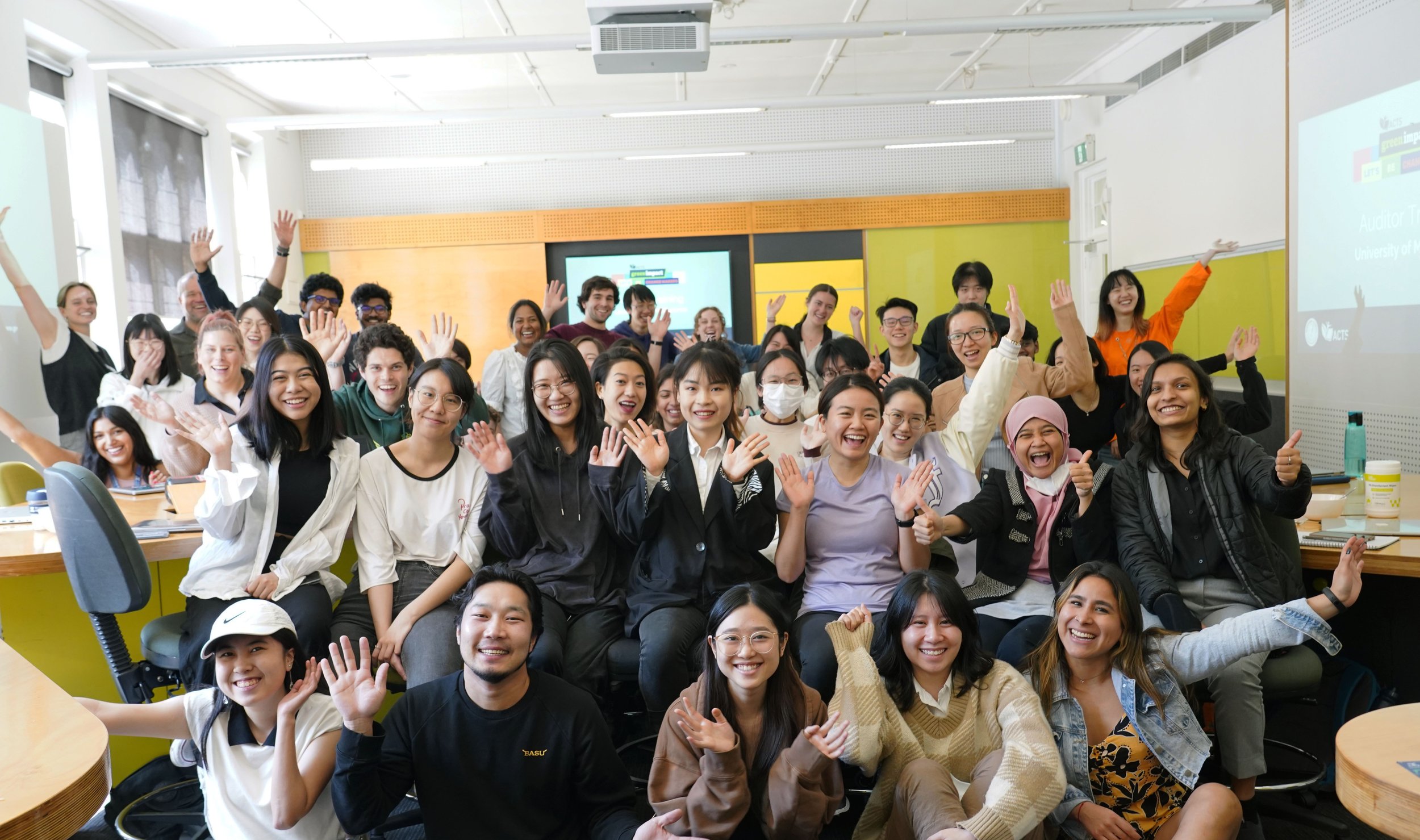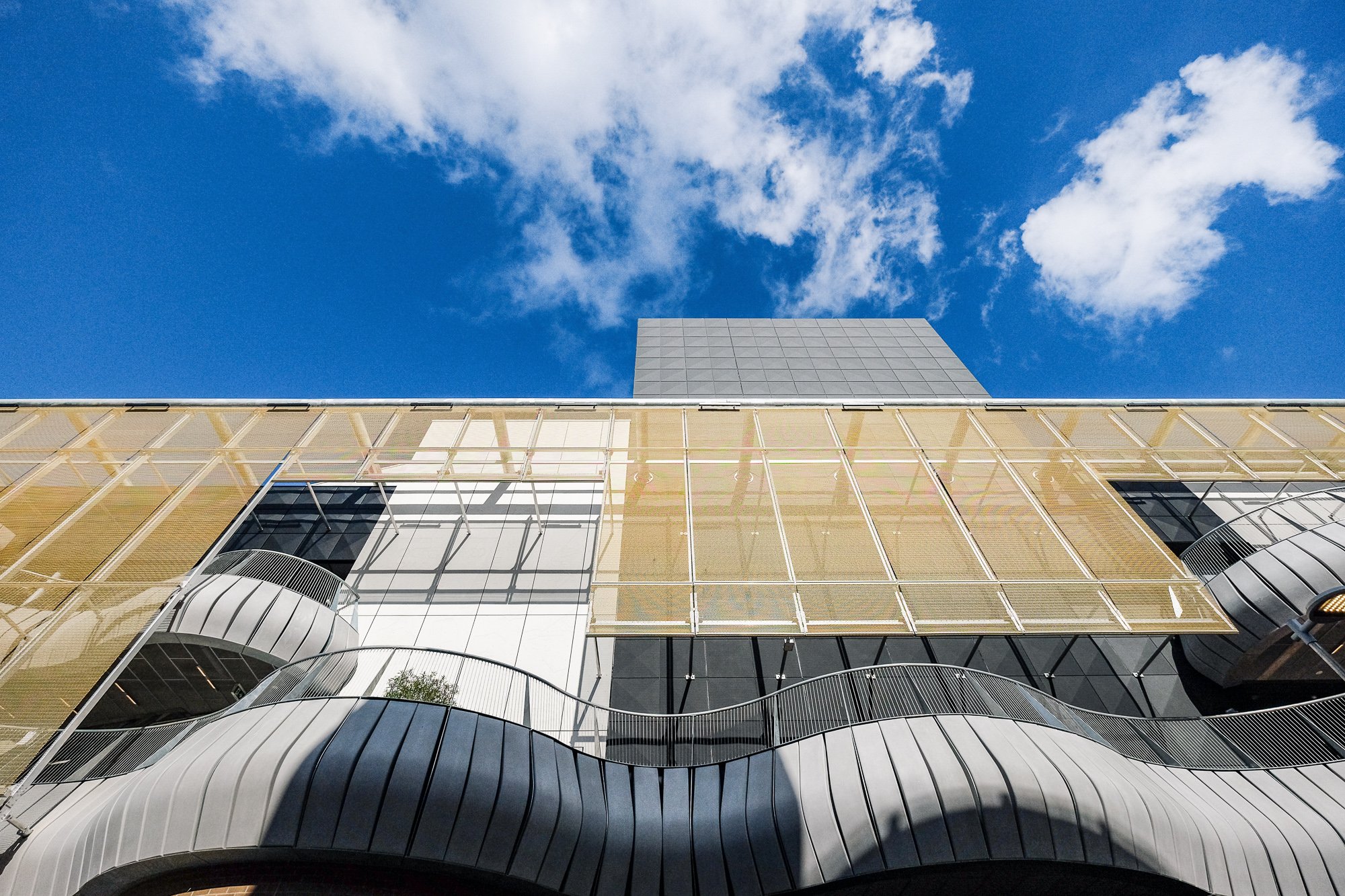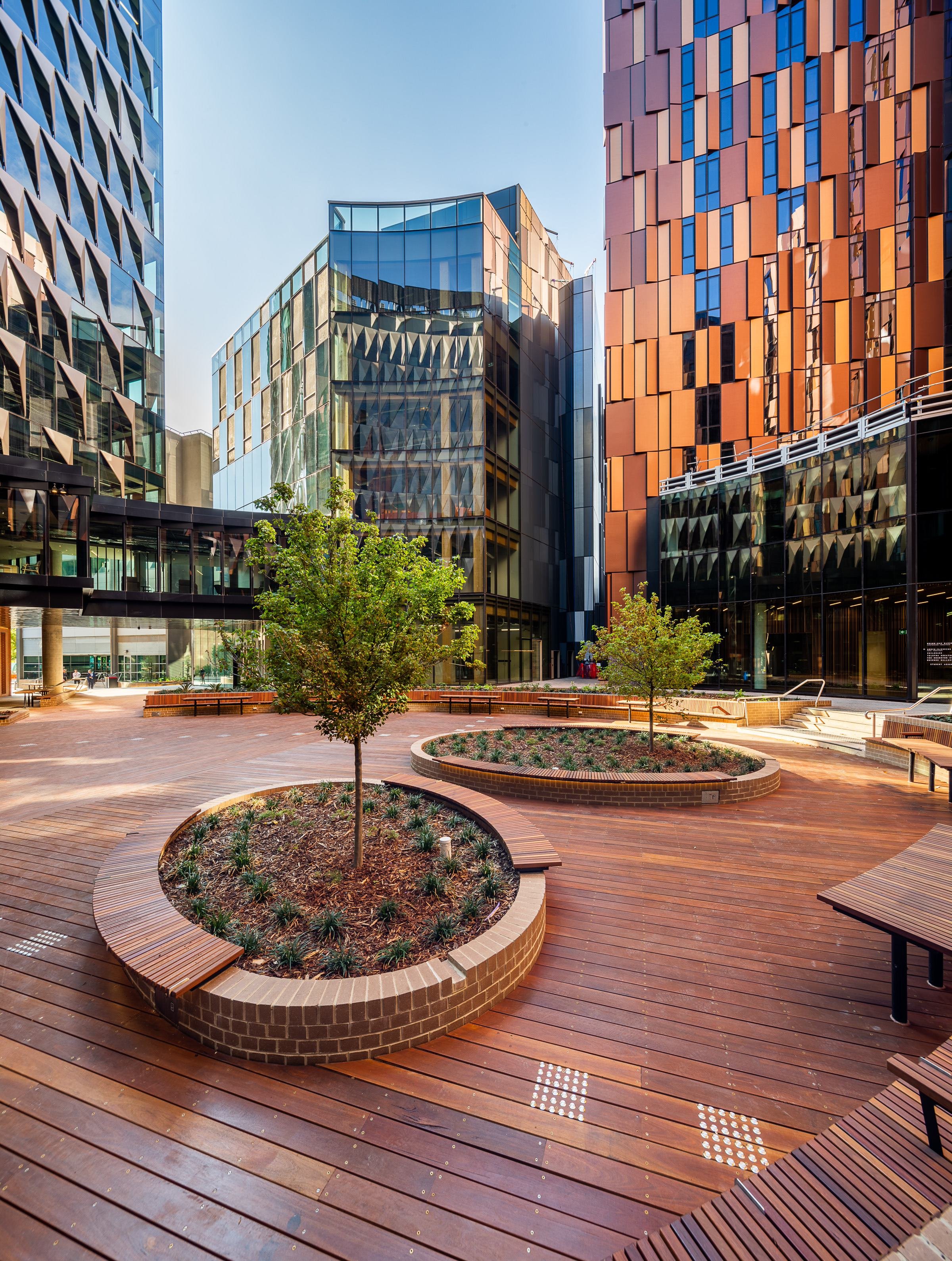
Our impact
Multi-faceted sustainability innovation in the Parkville Student Precinct Project
Located in the heart of the Parkville campus, the Student Precinct Project encompasses two new and five fully refurbished buildings, as well as a significant increase in outdoor landscaped areas. The project is one of the biggest investments the University has made in its iconic Parkville campus, and signals the University’s commitment to delivering a world-class, campus-based experience for all students.
As the first fully co-created major project in the University’s 170-year history, the voice of the community has been central to the project’s design and development. We heard from students who called for sustainability to be championed in all aspects of University life, from food and landscapes, to energy consumption and campus operations. Sustainability is deeply embedded in every aspect of the Student Precinct site, with all buildings designed to achieve a 5 or 6 Green Star Rating from the Green Building Council of Australia.
-
The project adopted a circular economy model throughout construction. From establishing a dedicated soft plastic recycling hub to sending truckloads of cleared bamboo to the elephants at the Melbourne Zoo, waste was treated as a resource and building materials were reused or repurposed wherever possible.
An innovative approach to construction had wider impacts across the campus and beyond. Bricks from the Alice Hoy Building were crushed and manufactured into paving for the terraces of the Student Pavilion, and concrete from the building was given to VicRoads for new roads around the state.
The Student Precinct was the first University major project to include social procurement targets. The head contract included a target of 3% of total spend to be awarded to Indigenous businesses and/or social enterprises and 3% of labour hours to be to minority groups. These targets were met, which delivered significant social value beyond the cost of the works to the community.
Read more about sustainability features in the Student Precinct Project.
-
Designed to be a ‘neighborhood hangout’, the Student Pavilion features an expansive kitchen to share and prepare food, plus a rooftop terrace with an Indigenous kitchen garden and robotic farms. Students can relax across four levels, with ample space for study, dining and socialising.
We know how important waste reduction is for our University community. Building on the circular economy philosophy used in its construction, the Student Precinct Project is a model for on-campus waste management and is working towards operating as a single-use plastic free hub. The site is home to an organic waste processor, fed with organic waste collected on-site, as well as a three-bin system.
As part of the Choose to Reuse Plate Program, all retailers are required to use mandatory crockery and dishwashing services, with restrictions on use of take-away containers and utensils. Waste from all retailers is weighed on-site, enabling us to understand sources of waste and identify reduction opportunities.
The Choose to Reuse program was developed and piloted at the University in 2019, and is an industry first in Australia in terms of its scale. The University’s Sustainability Team provided inductions for all retailers operating within the site to familiarise them with our high expectations for waste management.
In September 2022, the Sustainability Team hosted a Green Impact event in the student kitchen. Staff and students made vegan lemon cupcakes, learning several ways to use leftover lemon peels and prevent food waste.
Theatrum Botanicum, The Theatre of Plants
In 2022, Bachelor of Fine Arts Dance and Production Students created Theatrum Botanicum, a large-scale dance work exploring botany, soil ecology and gardening. Over 12 weeks, dance students worked with urban farmer, dancer and photographer Gregory Lorenzutti to create a garden on the grounds of the Southbank campus, culminating in a public performance over five nights in June.
The timespan of the project followed the natural rhythms of three seasons: Summer, Autumn and Winter. The curriculum included rich collaboration with guest artists and thinkers from across the University and externally, including visits to the University Herbarium and Systems Garden on the Parkville campus.
Reframing a dance production subject around plant life engaged dance students in practices of seeding, planting, cultivation, and environmental care, exploring the intrinsic connections between plant life and humans. Dance students explored soil and its microbiology, seeds, plant growth and natural systems design. They devised movement and choreographic scores based on their encounters with these natural materials and processes, with many experiencing a fundamental change their relationship with the living world.
Production students created sets and costumes with organic materials gathered from around the Southbank campus, growing much of the set on campus in the form of live plants which could be composted after the final performance – an active exploration of sustainable production practices in the performing arts.
The subject had a wider positive impact on the Southbank campus, with students transforming a patch of grass into an abundant garden, assisted by a $7000 grant from the Sustainability Team. The garden fostered a sense of community on the campus, providing edibles such as kale, lettuce and beans for students and staff to enjoy. Demolition of the garden in January 2023 raised important questions about the sustainability of initiatives like this in relation to established University systems and practices, providing fertile ground for further development and collaboration between students, academic and professional staff. Discussions about reinstating a community garden at Southbank are currently underway, complemented by greening across the campus in the form of modular planter beds and seating.
Theatrum Botanicum was a theme of the third-year production subject Inter-Disciplinary Project (DNCE30027) in 2022. Explore images and videos of Theatrum Botanicum on the Faculty of Fine Arts and Music website.
Images by Gregory Lorenzutti
Creativity and Community Resilience on Dookie campus
The Creativity and Community Resilience (CCR) studio launched in 2021 as a research collaboration between the University’s Centre of Visual Art (CoVA) and the Victoria Drought Resilience Adoption and Innovation Hub based at Dookie campus in regional Victoria. Studio collaborators include University researchers and community leaders from the Shepparton region.
In 2022, the studio held four workshops focused on using creative practice, imagination and playfulness to spark discussions about resilience in the face of climate change. Drawing on the food and agricultural focus of the Drought Hub, the workshops brought together University experts and regional Victorian communities to uncover shared concerns about food security and climate change among a broad range of stakeholders.
The final event in the 2022 program was a semi-performative ‘Dinner for the Future’, which brought together campus and community members in an imaginative context 20 years in the future to explore how we might experience extended drought more positively than in the past.
The CCR collaboration team shared outcomes from the dinner as part of the Future Drought Fund’s Science to Practice Forum 2022, representing the only creative-led project in the national conference program. The CCR project was initially supported by Melbourne Climate Futures in through a Climate Research Accelerator (CRX) grant, and has since received funding from Melbourne’s Lord Mayor’s Charitable Foundation. This additional support will enable the project to expand in 2023 to include urban communities in the Southbank and Queen Victoria Market precincts.
Images by Jeremy Lines
This project is one of several sustainability-focused initiatives on Dookie Campus. Other projects include:
Art and Ecology Residency
Supporting artists whose work focuses on themes of environment, agriculture and science to undertake research in active environmental science contexts. Over a three to four week residency, artists engage with life on campus, connecting with researchers and postgraduate students in Veterinary and Agricultural Sciences. Eight Artists in Residence were based at Dookie in 2022, working with local partners and exploring diverse themes.
Woka Watjerra Indigenous Garden Project
Developed in collaboration with the Faculty of Science, this native food garden program provides learning opportunities for students in the Indigenous-led Academy of Sport, Health and Education centre under the Victorian Certificate of Applied Learning work skills program. Woka Watjerra means ‘bush to plate’ in Yorta Yorta language. Working closely with Yorta Yorta Elders and University academics at Dookie, students are re-connecting with their cultural heritage, traditional plants, planting techniques, and cooking.
Sustainability – Hope for the Earth?
This interdisciplinary undergraduate subject introduces students to holistic models of sustainability, fostering critical thinking about the systems that progress sustainability as well as those that uphold unsustainable practices.
Students are empowered to take action in their own lives, their future careers, and in society at large. Together, academics and students face the scary realities of intensifying environmental and social crises, acknowledging the emotional distress that many feel in the face of these challenges and exploring opportunities to develop a sense of ‘active hope’ through individual and collective action.
Drawing on scientific, historical and Indigenous perspectives on sustainability, the subject provides students with conceptual tools to critically analyse the different factors that shape sustainability action, and opportunities to put them into practice.
Sustainability: Hope for the Earth? (UNIB10024) is an undergraduate breadth subject taught in the Faculty of Science.
-
The 2022 cohort brought together students from diverse academic backgrounds to explore the helpful and harmful impacts of their chosen discipline on environmental and social systems:
A Bachelor of Science (Data Science) student applied systems thinking and scale to understand the role of ‘big data’ in reaching SDG targets and improving tertiary sustainability education
A Bachelor of Biomedicine (Psychiatry) student applied needs, norms, and human-nature relationship analysis to examine the social and environmental sustainability of Western psychiatry practices
A Bachelor of Commerce (Sustainable Business) student applied needs analysis and systems thinking to understand the organisational change required for sustainable business practices
A Bachelor of Arts (Politics) student applied human-nature relationship analysis and power analysis to examine the cultural and environmental sustainability of tertiary politics education
A Bachelor of Science (Environmental science) student applied human-nature relationships analysis and systems thinking to investigate how the waste management industry can become more sustainable.
“This subject has taught me… to analyse what is contributing to the problem of unsustainability… and how to design strategies towards a more sustainable future. It made me question what my discipline has done and how helpful it really is toward sustainability.” – Min Thant (Tony) Aung, 2022 cohort
-
Students undertake real-world case study projects that use the University as a living laboratory and reveal the complexities of sustainability. They critically analyse on-campus sustainability challenges, identified in collaboration with our Sustainability Team and with reference to the University's Sustainability Report. Students feed back their research and suggested actions to the University during a Sustainability Symposium, providing novel suggestions and supporting evidence for how the University can continue to improve its sustainable practices.
“I came into this subject with a ‘blank slate’ mentality, and what I learned blew my mind. My view of sustainability is no longer limited to a discipline.”
– Min Thant (Tony) Aung, 2022 cohort
Melbourne Connect Living Laboratory
Launched in 2021, Melbourne Connect is a hub of climate and sustainability activity at the University. Located in Carlton alongside the Parkville campus, the precinct has achieved multiple 6-star Green Star ratings for its sustainable building design and is the first academic workplace in the world to achieve WELL certification, an international building standard for workplaces that enhance human health and wellbeing.
A purpose-built innovation precinct, Melbourne Connect was developed to foster collaboration, creativity and positive social impact. Within the precinct, researchers, start ups, industry, government, investors, higher degree students and the community unlock digitally-driven, data-enabled and socially responsible solutions to our most pressing challenges.
The precinct is used by the Faculties of Engineering and Information Technology (FEIT) and Architecture, Building and Planning (ABP) as a living laboratory – a test-bed for innovative sustainability monitoring technologies and processes.
-
FEIT staff and students use Melbourne Connect buildings and interior spaces to conduct research projects, teaching and learning. FEIT’s Centre for Spatial Data Infrastructures and Land Administration established a Digital Lab (D-Lab) in 2022 to provide technological capacity for the Melbourne Connect living lab. Led by Professor Abbas Rajabifard, D-Lab provides advanced interactive visualisation and data capturing tools to contribute to research and teaching in a wide range of scientific disciplines, including computer science, engineering, health sciences, art, architecture, and business.
In 2022, D-Lab scanned Melbourne Connect and created a ‘digital twin’ of the building – a fully interactive online model which can be used for analysis and experimentation. The data provides insights into building efficiency, how effectively the buildings meet the needs of users, and how they respond to our sustainability goals.
-
In 2022, ABP-based Sustainable and Healthy Environments Lab (SHE Lab) led a pilot study to understand how workplaces in Melbourne Connect are used and experienced by occupants post-COVID. Led by Associate Professor Christhina Candido, SHE Lab used innovative sensing technology, post-occupancy evaluation surveys and field studies to evaluate workplace fit-out, utilisation, indoor environment performance and overall user experience of a WELL-certified workspace.
Data gathered on performance of buildings and indoor environments can inform a range of improvements for existing and future assets, including retrofitting projects at the University and beyond. Examples include fine-tuning base building provisions and fit-out, improving indoor environmental quality and operational performance, predicting changes in space needs and utilisation, and verifying extreme weather performance.
SHE Lab’s living lab project focuses on providing students with authentic learning opportunities by demonstrating best practices in indoor environmental quality, interior design and building performance relevant to occupants’ satisfaction, productivity and health. The living lab provides students and researchers with hands-on experience in conducting diagnostic and performance evaluation of buildings and indoor environments.
International collaboration to support vulnerable nations at COP27
Photo by IISD/ENB
The University engages with local and international partners and collaborators to highlight the various ways climate change will affect Australia and our neighbours. Throughout 2022, the world was alarmed by the IPCC AR6 Reports on Climate Change, which a number of University researchers contributed to as lead authors, and which spurred intense discussion on the steps required to curb global warming.
The 2022 Conference of Parties (COP)UN climate change conference represented the culmination of the year’s efforts to create solutions to the climate crisis via diplomacy, advocacy and research. The University, led by our climate change research initiative Melbourne Climate Futures (MCF), played an important part in these discussions at COP27, which took place in Sharm El Sheikh, Egypt in November 2022.
After slow progress at COP26 in Glasgow, both as a result of COVID-19 attendance restrictions and an unwillingness by some states to negotiate productively, many were looking to COP27 to demonstrate real progress in the bid to meet Paris Agreement targets. In particular, the disproportionately heavy burden of climate change on poorer nations, most of whom generate very few emissions compared with their richer neighbours, was one of the keenly anticipated items on the agenda.
University researchers participated in a range of events at COP27, demonstrating its leading role at a forum that was focused on creating more positive climate future outcomes, in particular for vulnerable nations.
-
Together with the International Universities Climate Alliance (IUCA), MCF hosted an official COP27 side event titled Adaptation Priorities in the Indo-Pacific and Africa: Co-designed knowledge and solutions. This session explored key adaptation needs, priorities and options in Africa and the Indo-Pacific region. It highlighted the importance of adaptation and just transition, the dangers of loss and damage, and the urgent need to increase action and support for both, including through co-designed hubs.
Demonstrating its convening power, MCF brought together its own speakers, including Deputy Director Professor Kathryn Bowen and Enterprise Fellow Dr Janine Felson, with speakers from the Indian Institute for Human Settlements, the Republic of Marshall Islands, the University of Nairobi and the University of Oxford. In addition, MCF produced a co-branded content piece to support the COP27 side event, featuring Professor Michelle Mycoo from the University of the West Indies discussing the value universities bring in supporting climate action in small island nations.
-
As well as addressing the cost of climate change on neighbours in Asia and the Pacific, COP27 also revisited the need for nations to make deep, urgent and systemic changes to reduce emissions. MCF Academy Fellow Dr Kate Dooley presented The Land Gap Report, which looked at how governments are using land in climate pledges. The report analysed commitments made to 2030 and 2050 and found that 1.2 billion hectares in new forests and restored land – an area greater than that of the United States of America – would be required to help curb climate change. The research, which used MCF CRX funding to build and work with a range of international research partners, indicates that nations must find novel and more assertive methods of reducing emissions.





















